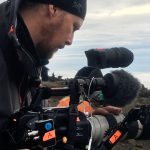User story: Syncing feature film action sequences
User profile
Peter Welch
Digital imaging technician
camerafacilities.co.uk
They typically involve fast-paced chases, sprawling locations, high-speed crashes and exploding massive amounts of pyrotechnics. As a result, feature film action sequences are full of unpredictability. They are also incredibly costly to get wrong. So when preparing for these pivotal scenes, every technological requirement is amplified, including the need for robust and reliable timecode.
“I take timecode very seriously, seeing it as part of the camera,” says Peter Welch, a digital imaging technician working on films including Spectre and Marvel’s Avengers 2: The Age of Ultron. “Although it doesn’t really affect us on set, later down the line, a break in timecode can cause other areas a whole world of problems.”
As a digital imaging technician, Welch’s role involves lining up the optimal combination of technical kit to overcome the challenges involved in shooting a scene. He works closely with the director of photography, camera crew, editorial and visual effects to make sure the right data is collected for post-production to transform raw digital footage into a polished movie as efficiently as possible. In the case of Avengers 2: Age of Ultron, creating the spectacular scenes and VFX we’ve come to expect from Marvel, involved developing solid workflows for a large number of very large multi-camera set ups. For some shots, as many as 12 cameras were rolling with a total camera package of 27 cameras including ARRI Alexa XT’s, Canon C500s with Codex Recorders, RED Epics and Blackmagic cameras. The huge amounts of data generated, made embedding accurate, perfectly synced timecode into every piece of footage an important technical requirement.
“One of the largest action sequences for Age of Ultron was filmed in Korea with eight cameras rigged to capture footage – four ARRI Alexas and four Canon C500s,” Welch says. “There was huge volumes of RAW output going to Codex recorders.”
While the Alexas were strategically rigged a safe distance from the main action, the C500s were placed in and around the explosion, putting them at an increased risk of being caught in the line of fire.
“A big part of my role is to anticipate it all going wrong,” Welch adds. “With this shoot, there was a chance that cameras could be taken out while filming, putting footage at risk of being lost.”
As an added complication, once the set was built, and definitely once it was hot with explosives, they couldn’t go back in to adjust camera settings. So whilst Welch was able to manually jam sync the Alexas, the C500s had to be set to record with timecode running at the point of rigging. There wasn’t an opportunity to go back later and re-jam midway through the day, they had to stay in sync throughout, whatever twists and turns the filming process took.
With the C500 cameras placed in strategic positions to maximise the action, the Codex recorders, Preston MDRs and power were built into recording and camera control boxes (or ‘safe boxes’) and positioned at a distance from the cameras and then connected via a bespoke set of cables. Within each C500’s ‘safe box’ he also placed a Timecode Systems: minitrx+ set in receive mode. This was synced over RF to a master unit back outside of the ‘hot’ zone. With an internal Li-Polymer battery powering it for up to 12 hours, the :mintrx+ units in the C500 ‘safe boxes’ could be left running throughout a long shooting day with complete confidence and no requirement for manual jamming or resetting. This set-up ensured all footage captured by the C500s in the ‘hot’ zone was stamped with the same frame accurate timecode as the Alexas. The timecode could also be monitored via the return video signal’s embedded SDI feed.
But it’s not just the pyrotechnics that inject unpredictability into shooting this kind of scene – the sheer scale of the locations can be as much of a challenge.
“Whatever system we build for an action sequence, it has to be reliable and flexible because you can never second guess what’s going to happen next,” says Welch. “The ability to synchronise timecode over RF definitely helps as there is always a chance a camera could be taken further away than we have control of.”
But even with long range RF, it’s good to have a back up. In one scene in Spectre, 007 pilots a motorboat down a sizeable stretch of the Thames in London.
“For this scene I rigged one camera with a :minirtx+ on a boat in Putney, powered it up and left it on-board filming Bond,” Welch explains. “I then got in my car and raced down the Embankment to Westminster to set up the main technical base with the camera crews, with a Timecode Systems unit set to the same timecode as that on the boat.”
Even though the boat started its journey out of range of its paired unit, the crystal inside the :minitrx+ continued to feed timecode to that camera accurately. As soon as the boat powered back into range, it synced back to the master unit again with zero drift. There was no need to re-set or re-jam.
But as spectacular as a motorboat skimming across the Thames driven by James Bond was, it’s the helicopter scenes in Mexico and the aerial chase scenes in Austria that steal the show in the latest Bond film.
“In Austria, we mounted :minitrx+ units onto the cameras in the helicopters to capture aerial to aerial footage,” Welch explains. “We jammed all the units early in the day back at the helicopter base but had the confidence they would stay in sync wherever they went, picking up the master clock as soon as they were back in range of each other.”
Films like Spectre and the Avengers franchise, show how action sequences are getting increasingly ambitious. To create these visual effects, footage is being captured from an growing number and variety of camera sources, adding complications to the production workflow. Although it’s possible to fix sync problems in post-production, it’s time consuming and expensive. Getting it right, as Welch did, at the point of shooting offers considerable efficiencies to the production process. Something that every production demands – even those working with Hollywood-sized budgets.
Tell us what you sync
Have you used our system on an interesting shoot? Please contact us to share your user story.






